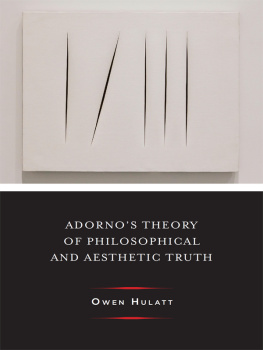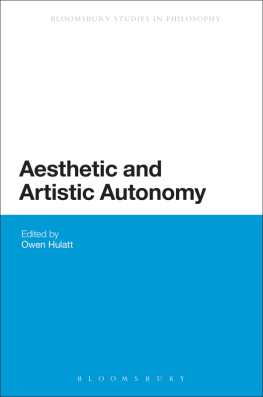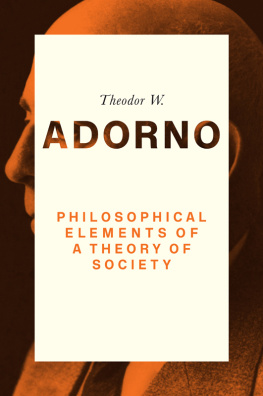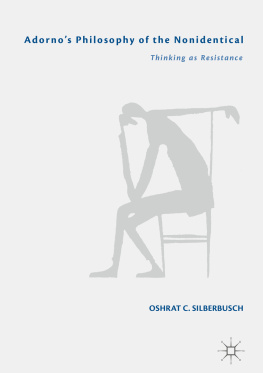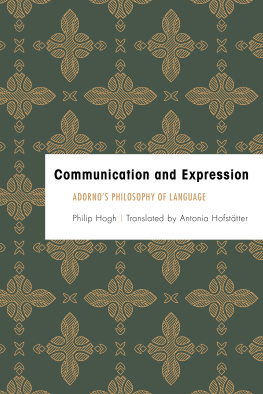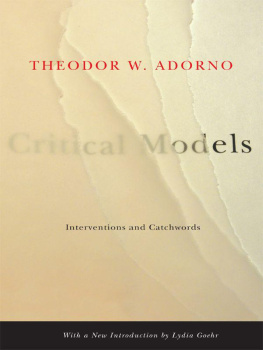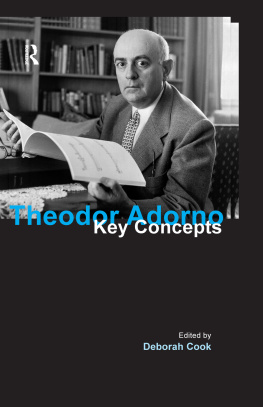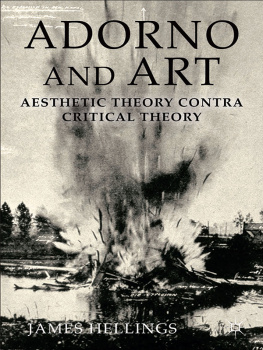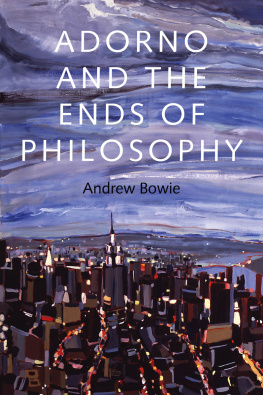Table of Contents
Adornos Theory of Philosophical and Aesthetic Truth
COLUMBIA THEMES IN PHILOSOPHY, SOCIAL CRITICISM, AND THE ARTS
COLUMBIA THEMES IN PHILOSOPHY, SOCIAL CRITICISM, AND THE ARTS
Lydia Goehr and Gregg M. Horowitz, Editors
ADVISORY BOARD
| Carolyn Abbate | Arthur C. Danto |
| J. M. Bernstein | John Hyman |
| Eve Blau | Michael Kelly |
| T. J. Clark | Paul Kottman |
Columbia Themes in Philosophy, Social Criticism, and the Arts presents monographs, essay collections, and short books on philosophy and aesthetic theory. It aims to publish books that show the ability of the arts to stimulate critical reflection on modern and contemporary social, political, and cultural life. Art is not now, if it ever was, a realm of human activity independent of the complex realities of social organization and change, political authority and antagonism, cultural domination and resistance. The possibilities of critical thought embedded in the arts are most fruitfully expressed when addressed to readers across the various fields of social and humanistic inquiry. The idea of philosophy in the series title ought to be understood, therefore, to embrace forms of discussion that begin where mere academic expertise exhausts itself; where the rules of social, political, and cultural practice are both affirmed and challenged; and where new thinking takes place. The series does not privilege any particular art, nor does it ask for the arts to be mutually isolated. The series encourages writing from the many fields of thoughtful and critical inquiry.
See after the Index.
ADORNOS THEORY OF PHILOSOPHICAL AND AESTHETIC TRUTH
Owen Hulatt
Columbia University Press New York
Columbia University Press
Publishers Since 1893
New York Chichester, West Sussex
cup.columbia.edu
Copyright 2016 Columbia University Press
All rights reserved
E-ISBN 978-0-231-54220-3
Library of Congress Cataloging-in-Publication Data
Names: Hulatt, Owen, author.
Title: Adornos theory of philosophical and aesthetic truth / Owen Hulatt.
Description: New York: Columbia University Press, 2016. | Series: Columbia themes in philosophy, social criticism, and the arts | Includes bibliographical references and index.
Identifiers: LCCN 2016006294 | ISBN 9780231177245 (cloth: alk. paper) | ISBN 9780231542203 (e-book)
Subjects: LCSH: Adorno, Theodor W., 19031969. | Truth. | Truth (Aesthetics) | Aesthetics. | Knowledge, Theory of.
Classification: LCC B3199.A34 H844 2016 | DDC 121.092dc23
LC record available at https://lccn.loc.gov/2016006294
A Columbia University Press E-book.
CUP would be pleased to hear about your reading experience with this e-book at .
JACKET DESIGN: Rebecca Lown
CONTENTS
The ideas developed in this book are the product of many years of thought about not only Adorno, but also many related philosophers falling both within and without the Continental tradition. I would like to thank here the many people with whom I have shared discussions, mutual interests, and fruitful disagreements over these years, and from whom I have learned so much.
I am very grateful to Brian OConnor and Peter Lamarque for their detailed and sympathetic criticism on ideas about art and philosophy that have found expression in print both here and elsewhere, and also for their continual advice and encouragement. Brian and Peter are not only preeminent in their field, but also genuinely warm men I am very pleased to know.
A great many of the ideas in this book were first discussed with James Clarke, and explored and sharpened through many exacting arguments, reading groups, and exegeses. I continue to be grateful for his insight.
I must also give special thanks to Fabian Freyenhagen. In our correspondence we have discussed a great number of ideas and papers, and Fabians detailed, incisive, and constructive criticismeven and especially on those areas where we do not agreehas always redounded to the benefit of my thought and work. Both Fabian and Brian read over a complete draft of this book, and what clarity it has is at least partially owed to them. I also thank Matthias Rothe for his very helpful comments on an earlier draft of this book.
I have also been very fortunate, more generally, to be able to discuss philosophy with my colleagues at York. The Department of Philosophy at the University of York has a strong tradition of detailed and clear engagement with the history of philosophya tradition in which I hope this book stands. I have benefited from discussing the history of philosophy with a great number of my colleagues in this vein, most especially Tom Baldwin, Mike Beaney (with whom I first read Husserl), and Tom Stoneham.
I am very grateful to Lydia Goehr for her support and encouragement for my submitting a proposal to Columbia University Press, and for her guidance and counsel throughout the process. I also thank Gregg Horowitz, Christine Dunbar, and Wendy Lochner, for all of their guidance and forbearance in the course of my preparing this book for publication.
Elements of draw on, and significantly rework and expand on, parts of my earlier paper Critique Through Autonomy: Of Monads and Mediation in Adornos Aesthetic Theory, in Aesthetic and Artistic Autonomy, ed. Owen Hulatt (London: Bloomsbury, 2013), 171197.
Brendan Harrington is a deeply talented philosopher and truly great friend whom I am proud to know. The pleasure of discussing philosophy is nothing measured against, in friendship, the experience of understanding and being understood.
My parents, my sister, and my grandparents have all been integral to my life, in the love, upbringing, and values they have given me. I am very grateful to them, and am sure all our life together finds some reflection, however oblique, in this book. Finally, Lauren, my wifeto simply offer thanks seems too meager. I can only say that my life, let alone the things that occur in it, would lose its color, its savor, and its point without her.
At time of writing, our daughter is a few months from being born. She has been restless from the first time we saw her, like her parents. I hope she has her mothers goodness. We are both looking forward to our first meeting, and I dedicate this book to her.
Art seems to speak to us. Anyone familiar with art will be familiar with the sensation that the artwork conveys something, and the feeling that what is conveyed is of significance. It gives us a desire to knowto put our finger onjust what it is the artwork has to say. An equally familiar experience is the ultimate futility of trying to give what the artwork conveys expression in our own words. We are invited, and ultimately rebuffed, by art. It refuses to enter into our language without remainder. One tempting response is to give the verdict that art merely seems to speak to us; it generates only a pretense of epistemic or cognitive value. Ultimately, one might be tempted to conclude, all the artwork has to offer is mere aesthetic stimulation.
Perhaps one of the enduringly valuable features of Adornos work on art is his refusal of this temptation. Art really does speak to us, Adorno claims, but in a highly complex and unusual way. What it seeks to convey resists complete expression in our concepts, in our languagebut this is because what it seeks to convey is a critique of and an attack on our concepts. Artworks are trueand their truth is aimed against the falsity of our way of thinking, and designed to elude capture by that way of thinking.

